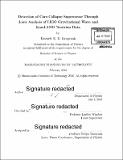Detection of core-collapse supernovae through joint analysis of LIGO gravitational wave and KamLAND neutrino data
Author(s)
Krupczak, Emmett E. E
DownloadFull printable version (3.685Mb)
Other Contributors
Massachusetts Institute of Technology. Department of Physics.
Advisor
Lindley Winslow.
Terms of use
Metadata
Show full item recordAbstract
Introduction: Core collapse supernova are one of the most intriguing astrophysical phenomena. The dying stage of a supergiant star, they occur when the star collapses into a protoneutron star, causing a shock wave and a gamma ray burst. High energy neutrinos are released in this process and offer the possibility of detecting these elusive cataclysms. The number of neutrinos emitted is large but at best only a few will be detected. With a multi-messenger search, we can combine the neutrino signal with another clue to the presence of a supernova: gravitational waves. During the proto-neutron star stage, a fast-rotating star can produce gravitational waves via its asymmetric and rapidly shifting mass. By combining the signals from neutrinos and gravitational waves, we can attempt to detect supernova signals that are too faint to detect alone. Joint searches have already been attempted by several neutrino experiments with high-energy thresholds, including ANTARES and IceCube. This thesis explores the possibility of a joint search with a new set of neutrino data. KamLAND (Kamioka Liquid scintillator Anti-Neutrino Detector) is a large particle detector located in Kamioka, Japan. KamLAND is well-shielded, with an low (~ 1 MeV) energy threshold and has more than ten years of data to explore, making it a good candidate for a joint search. A recent search of KamLAND's data for clustered events indicative of supernova found no clear clusters. A new search is needed to identify single-neutrino events that may have originated in supernovae. A joint search will help KamLAND more carefully examine the possible sources of its single-neutrino events. The gravitational wave data comes from LIGO (Laser Interferometer Gravitational wave Observatory). Located in Hanford, WA and Livingston, LA, LIGO consists of two four-kilometer interferometer arms. Analysis of LIGO data from 2005 to 2010 did not produce any clear gravitational wave events, leading to a need for a more sensitive search. A multimessenger search in conjunction with KamLAND provides this opportunity. We can examine both KamLAND and LIGO's data in order to search for possible supernova signals observed by both experiments. Because a joint data-sharing agreement has not been reached between KamLAND and LIGO, this thesis looks at the potential of a joint analysis and the opportunity for such a study to produce promising results.
Description
Thesis: S.B., Massachusetts Institute of Technology, Department of Physics, 2016. Cataloged from PDF version of thesis. Includes bibliographical references (pages 45-47).
Date issued
2016Department
Massachusetts Institute of Technology. Department of PhysicsPublisher
Massachusetts Institute of Technology
Keywords
Physics.